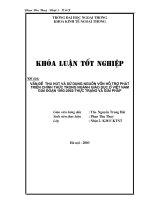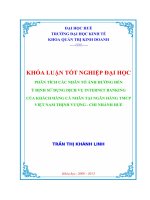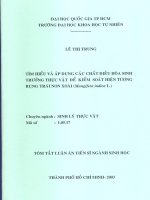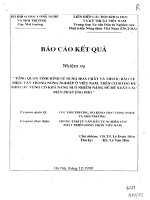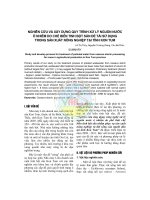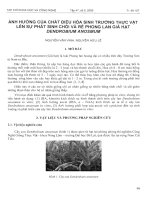Khôi phục các sự kiện khô hạn dựa trên vòng sinh trưởng thực vật tại tỉnh kon tum, việt nam
Bạn đang xem bản rút gọn của tài liệu. Xem và tải ngay bản đầy đủ của tài liệu tại đây (3.41 MB, 105 trang )
VIETNAM NATIONAL UNIVERSITY, HANOI
SCHOOL OF GRADUATE STUDIES
NGUYỄN THỊ OANH
RECONSTRUCTION OF DROUGHT EVENTS BASED ON
TREE RINGS IN KON TUM PROVINCE, VIETNAM
MASTER THESIS
MAJOR CLIMATE CHANGE
HA NOI – 2015
VIETNAM NATIONAL UNIVERSITY, HANOI
SCHOOL OF GRADUATE STUDIES
NGUYEN THI OANH
RECONSTRUCTION OF DROUGHT EVENTS BASED ON
TREE RINGS IN KON TUM PROVINCE, VIETNAM
MASTER THESIS
Major: Climate Change
Code: Training Program
Supervisor : Assoc. Professor Lora Stevens-Landon
Assoc. Professor. Vu Van Tich
HÀ NỘI – 2015
REASSURANCES
I assure this is my research. The data and results in my thesis are honest and have
never been published in any other research.
STUDENT
Nguyen Thi Oanh
ACKNOWLEDGEMENTS
This has been a rewarding and gratifying experience. I am thankful to the following
people, without whom the completion of this thesis would not have been possible
Thank you Associate Professor Lora Stevens Landon for your invaluable comments
and advises. Meetings with you have been enlightening. Thank you for your patience,
time, and words of encouragement which have sustained me throughout this academic
journey. Also Thank to Associate Professor Pham Van Cu, VNU-ICARGC and
Fulbright scholar program.
Thank you Associate Professor Vu Van Tich for your guidance during the initial
stages of the research processes which has helped me in the development of ideas.
Thank you Professor Brendan Buckley, Tree ring laboratory – Lamont - Doherty Earth
Observatory was enabling me to study a lot of software about tree rings. I am grateful
to you, PhD. Le Canh Nam, Dr. Le Xuan Thuyen, Mr. Nguyen The Hoang and Mr.
Pham Gia Tuong for all your support when I decided to choose this research and help
me take sampling
To Tran Thi Thu Trang and Nisha Ramdzan, thank you for helping me with reading
my thesis amidst your busy schedules. Thank you for also being my pillars of support,
always showing me care and concern, and for buying, making and sharing sweet treats
with me
To the Climate Change Class of 2013/2015: thank you for the fun and friendships that
have make my university life memorable.
And to all others who have helped, supported and encouraged me in this journey,
thank you. I really appreciate it.
Above all, I am most grateful for having a loving family that always showers me with
unending love, patience and care. To my dearest daddy, mummy, sister, brother and
boyfriend, you have been my greatest source of emotional support that has kept me
going, especially whenever I am stressed. Thank you for seeing me through the most
difficult days.
CONTENTS
LIST OF ABBREVIATIONS .......................................................................................1
LIST OF TABLES .........................................................................................................2
LIST OF FIGURES .......................................................................................................3
INTRODUCTION .........................................................................................................5
* JUSTIFICATION FOR RESEARCH ........................................................................5
* PURPOSE OF THESIS ..............................................................................................6
* TASKING OF THESIS ...............................................................................................6
* THE MEANING SCIENTIFIC AND PRACTICAL OF THESIS ...........................6
* SUBJECTS AND SCOPE ...........................................................................................7
* RESEARCH QUESTION ...........................................................................................7
CHAPTER 1: BACKGROUND ...................................................................................8
1.1.
Overview of tree rings..............................................................................................................8
1.1.1.
Application of dendrochronology in study of climate change ..............................................8
1.1.2.
Overview for formation of tree ring. ....................................................................................9
1.1.3.
A review of other studies that have used tree rings. .......................................................... 13
1.1.4.
The external factors affecting the growth of tree rings. .................................................... 18
1.1.5.
Introduction of Fokienia hodginsii .................................................................................. 19
1.2. Characteristics of climate in Kon Tum .............................................................................. 20
CHAPTER 2: METHODS AND STUDY AREA .....................................................22
2.1.
Study area ............................................................................................................................. 22
2.1.1.
Natural geographic characteristics related to tree growth ............................................... 22
2.1.2.
Ecosystems in KonPlong, Kon Tum .................................................................................. 23
2.2. Methodology .................................................................................................................... 23
2.3. Field Collection ................................................................................................................ 24
2.4. Laboratory Methods ......................................................................................................... 28
2.4.1. Sample Preparation and Measuring in the laboratory. ......................................................... 28
2.4.2. Cross-dating and Master Chronology Development............................................................... 28
2.4.3. Statistical Analysis of Climate Response and Standardization .............................................. 30
CHAPTER 3: DENDROCLIMATOLOGICAL ANALYSES AND
RECONSTRUCTION DROUGHT EVENTS BASED ON TREE RINGS ...........33
3.1 Tree-ring Chronologies and Tree ring index ...................................................................... 33
3.2. Climate Response ............................................................................................................. 35
3.2.1 Precipitation ............................................................................................................................. 35
3.2.2 Temperature ............................................................................................................................. 37
3.2.3 Palmer Drought Severity Index and Climate Teleconnections ................................................ 40
3.2.4. The relationship between the tree ring index with ENSO phenomenon .................................. 42
3.3. Compared with some studies in Vietnam and Climate reconstructions............................... 45
3.4. Discussion........................................................................................................................ 48
CONCLUSIONS AND PERSPECTIVES .................................................................52
REFERENCES ............................................................................................................54
LIST OF ABBREVIATIONS
SYMBOL
MEANING
TRW
Tree ring width
T1
Temprature on January
Kd
Tree ring width index
PDSI
Palmer Drought Severity Index
ENSO
El Nino- Southern Oscillation
1
LIST OF TABLES
Table
Content
Page
Table 1.1
Climate changes over years in Kon Tum
19
Table 3.1
Characteristics of statistic of tree ring index
33
Table 3.2
The correlation between tree ring index with precipitation
34
Table 3.3
The correlation between tree ring index with temperature
36
Table 3.4
The correlation between tree ring index with PDSI
40
Table 3.5
The El-Nino occurred in Vietnam Central Highlands
42
2
LIST OF FIGURES
Figure
Figure 1.1
Figure 1.2
Figure 1.3
Figure 1.4
Figure 2.1
Figure 2.2
Figure 2.3
Figure 2.4
Figure 2.5
Figure 2.6
Figure 2.7
Figure 2.8
Figure 3.1
Figure 3.2
Figure 3.3
Figure 3.4
Figure 3.5
Figure 3.6
Figure 3.7
Figure 3.8
Figure 3.9
Content
Annual growth ring
A missing ring in an annual ring
The higher temperature or lower rainfall were found to
create narrow tree ring width
Monthly mean temperature (black circles) and precipitation
(black bar) (from 1976 to 2013) at the Kon Tum
instrumental station
The administrative map of Kon Tum
Sampling locations and/or measured for this study.
Sampling plots from living trees were collected from the
Mang But commune, KonPlong district, KomTum province
Borer to take tree ring samples
Taking tree sampling
Tree ring core
Tree ring core’s tray
Measurement of tree-ring samples is conducted on a moving
stage micrometer (foreground) under a microscope. The
micrometer is hooked to a rotary encoder (on left end of
measuring stage), a digital display (upper left), and
eventually to a personal computer
Using Coorecoder 7.7, CDendro 7.7 to counted and
measured tree ring width (the number in the picture is the
corresponding tree ring)
Characteristic of Po-mu’s tree rings.( in FHMB33C: absent
ring in 1835, compare with FHMB33B)
Tree ring width of Po-mu from 1467 to 2013
Correlation coefficients between climate (total monthly
precipitation), and tree growth over the period 1976–2013.
Values for the coefficients greater than 0.30 or less than –
0.3 are statistically significant
Correlation coefficients between climate (the average
monthly temperature), and tree growth over the period
1976–2013. Values for the coefficients greater than 0.3 or
less than –0.3 are statistically significant
The dry periods with high temperatures evidenced by
narrow tree ring index
The dry periods with low precipitation (on May) evidenced
by narrow tree ring index
Correlation coefficients between PDSI, and tree growth
over the period 1911–2005
The relationship between tree ring index and PDSI
The variation of tree ring width index with the El-Nino and
La -Nina phenomenon (The source of ENSO da ta in NOAA
3
Page
10
12
17
20
21
24
25
26
26
27
27
28
32
34
35
37
38
39
40
41
43
Figure 3.10
Figure 3.11
Figure 3.12
website)
Rebuilding drought index (PDSI) following chronology of
Fokienia hodginsii tree ring index. (Source: B.M.Buckley,
2008)
The chronology of tree ring width of Po-mu in KonPlong
from 1467 to 2013
The variation of Fokienia hodginsii tree ring width in the
samples: 07A, 34B, 40C and 41A in the Konplong region
4
43
44
45
INTRODUCTION
* JUSTIFICATION FOR RESEARCH
Climate change has become an important global problem. The immediate
action to combat climate change is to identify the cause of it, find ways to reduce
the warming of the Earth, and to study the past climate variability to understand
the magnitude of recent climate changes. It is important to understand the causes
and consequences of the climate changes in the past from tree rings and historical
records in order to interpret today‟s climate change and to prepare for future
climate change.
Tree rings are able to record the fluctuations of environmental factors that
influence tree growth during the life of the tree. In most cases, trees live hundreds
or even thousands of years and, thus, are an important source of information about
environmental change. Instrumental records of climate or other types of
environmental variations exist for less than 100 years in most parts of the world.
This length of record is not sufficient to answer questions such as: Is the current
global warming unusual, or is it part of the natural climate variability that we can
expect over the long term? What is the range of precipitation variability that can
be expected over centuries and millennia? With the climate information obtained
from tree rings, we can begin to answer such questions. In addition, other
questions such as: How can we know the temperature in the past for thousands of
years? Did the climate change movement gradually or suddenly in the past? How
did the climate mechanisms change overtime? Can humans predict when climate
change will occur? Through the study of tree rings, many of these questions can be
partially answered.
The annual growth ring is one of the witnesses of climate change in Earth's
history. Based on the relationships between the tree rings width and ecological
factors, the monthly and annual temperature, humidity and precipitation over long
period of times can the climate in the past through "looking out for signs indicate
or change the rules of this relationship, which can reconstruct the base predict
changes in future climate " [6]. The results of the study will provide the
information necessary for paleoclimatologists to obtain the trends of climate and to
5
identify the historic droughts in the past. In addition, this research is important in
today's context as global warming, caused by frequent emissions from human
production operations, and increase deforestation, has been interpreted as the
cause of the rapid glacial melting and extreme weather events.
The analysis of annual tree ring growth cycle includes the expression of the
growth and development through color and width. However it is important to note
that more than one factor (climate conditions) can affect tree growth. Other factors
such as soil condition, competition, animals, and microorganisms may contribute
to the variation in growth and structure of tree rings.
* PURPOSE OF THESIS
- Analysis of the influence of climatic factors affecting growth of Fokienia
hodginsii in KonPlong, Kon Tum, Central Highlands.
- Indicates the drought and heavy rains in the history of this region.
* TASKING OF THESIS
- Collected, processed and standardized tree ring samples, the climate data
- Using a cross-date precision sowing calendar year for each tree ring, the
COFECHA, arctan, Re- Coocorder 7.7 softwares .... find absent rings and false
rings.
* THE MEANING SCIENTIFIC AND PRACTICAL OF THESIS
The meaning Scientific:
- The thesis provides ancient climate history datas in the service of climate
change scientist in the region
- The thesis provides a database to analyze the ecological characteristics of
Fokienia hodginsii.
The meaning Practical:
- As a reference value for the study of ancient climate and climate changes
in the past in the region as well as in Vietnam.
- The results of the thesis is also an important base for the development
ecological characteristics of Fokienia hodginsii.
6
* SUBJECTS AND SCOPE
Study subjects:
- The growth of Fokienia hodginsii (Local name: Pơ-mu) is largely
influenced by the temperature and precipitation in Kon Tum. The reaction of the
tree with these climatic factors was assessed through fluctuations of tree ring
width.
Scope of the study:
- The scope of the research is on Fokienia hodginsii trees at the upstream of
Đak Bla River at Đak Giak village- Mang But commune - KonPlong district- Kon
Tum province.
- Scope of content:
+ The thesis is only concerned with climatic factors, which affect the
growth of Fokienia hodginsii such as rainfall, temperature , PDSI and ENSO.
+ The results from the tree rings will be compared to the drought
documented in historical record.
* RESEARCH QUESTION
Topic: “Reconstruction of drought events based on tree rings in Kon Tum
province, Viet Nam”. This research provides information on the climate history (c.
AD 1250 – present) in the region. The information on tree rings provides a
database for the analysis of the ecological characteristics of Fokienia hodginsii
then investigating the influence of climatic factors on the growth of Fokienia
hodginsii in KonPlong district, Kon Tum province, Central Highlands.
Fokienia hodginsii be used for climate reconstructions?
7
Can
CHAPTER 1: BACKGROUND
1.1.
Overview of tree rings
1.1.1. Application of dendrochronology in study of climate change
Dendrochronology is the analysis of tree rings, including the dating of
annual rings and the study of ring characteristic patterns, such as width, density,
and isotopic composition. In the mid- to upper latitudes, or areas where there is
seasonality in temperature and/or precipitation, many species of trees form annual
growth rings. Since the same set of environmental factors influence tree growth
throughout the region, the patterns of ring characteristics, such as ring widths, are
often common between trees. These patterns are matched between trees, through a
process called crossdating, which is used to assign the exact calendar year dates to
each individual ring. The dated and measured ring widths from the trees in the
region are then combined to form a tree-ring chronology. The chronology provides
two main types of information.
The chronology can be used as a tool for dating events that caused tree
death or to mark the change in the appearance of a ring or set of rings. The death
date can be used to date the tree cutting involved in the construction of wooden
dwellings. Scars on tree rings can record the timing of events such as fire, flood,
avalanche, or other geomorphological events, while sequences of suppressed or
larger rings record events can record the timing of events such as insect
infestation, effects of pollution, or changes in forest dynamics.
The chronology is an average of coherent variations in growth from a
number of trees. It enhances the common pattern of variation or "signal" usually
related to climate while the non-common variance, or "noise" is dampened.
Chronologies from trees that are sensitive to climate can be used to reconstruct
past variations in seasonal temperature, precipitation, drought, stream flow, and
other climate-related variables.
Dendroclimatology is based on the analysis of the relationship between tree
rings width and climatic factors. Analysis on the changes in tree ring widths are
compared to climate information in order to find out the climatic factors influence
the growth of tree rings [56].
8
Based on tree ring widths, the climate reconstruction models of the past can
be produced. Using the past climate model, the scientists is able to continue to
study the future climate change. The results of these studies will add to the
repository of documents for the research of climate change not only in Vietnam
but also around the world.
1.1.2. Overview for formation of tree ring.
The growth of annual tree ring is the result of many environmental factors
that occurred in 1 year. The environmental factors are largely dependent on the
geographical location. For example, in the area of coniferous tree species in
Vietnam, alpine growth cycle coincides within a year. The tree ring width reflects
the rate of the tree growth while the number of tree rings represent the age of tree.
The tree rings when viewed from the cross section can be seen as concentric
circles while from the radial cross-section, the rings can seen as parallel to each
other and parallel to the longitudinal axis trunk. The rings are depended on the
biological characteristics of the species, characteristic of weather conditions and
nutrition received [1]. The xylem in conifers is composed mostly of tracheid cells.
A tracheid cell is long and thin and might be compared to a soda straw with both
ends slightly tapered and closed. The long axes of the cells run parallel to the long
axis of the stem or branch.
The annual ring is divided into two parts, early wood and late wood. As the
name imply, early wood tracheids are formed at the beginning of each growing
season and during the period of rapid radial growth, whereas latewood trachieds
are formed towards the end of the growing season when cambial activity slows
down. In latewood, trachied walls are thick, strong and appear dark in color, and
their cavities are progressively smaller. It is the sharp contrast between the lastformed latewood cells of one growing season that delineates the boundary of an
annual ring. Due to the sharp contrast between the two cell types, annual rings can
be seen in most cross sections without magnification [30]. Thus the boundary
between early wood and late wood is clearly recognizable from the transition from
light-colored wood to dark-coloured wood [39]. The difference in size and density
of the wood affects the difference in the rate and the period of cell formation [36]
9
[41]. During to the growing season, the annual growth rings of coniferous trees
can be seen more clearly compared to broadleaf trees. However, there are still
difficulties in differentiating narrow widths and large widths as it can appears as a
missing ring or a false ring [6]. During wet conditions such as heavy rain, the
availability of water and sunlight enable the the tree rings growth to be larger
compare to periods of droughts.
On the other hand, majority of the tree rings of coniferous trees are able to
capture the weather changes in a year. Reasearch on the width of early wood and
late wood of the coniferous trees will provide information on climate changes in a
year.
Under certain climatic conditions, some species will form intra-annual or
false rings. If climatic conditions are unfavorable to growth during the growing
season, the tree may mistaken it as the end of the season and produce dark, thickwalled latewood cells. When the climatic conditions improved, this will cause the
tree to produce lighter, thinner-walled cells again and it will continue to do so till
the true end of the season. This will cause the resulting annual ring to look like
two rings. However, with closer inspection, the ring can be identified as a false
because the latewood boundary grades back into the earlywood.
10
Figure 1.1. Annual growth ring (Sourse: Fritts, 1976)
Missing rings (absent rings): Under harsh climate conditions, trees may
produce only a partial ring or may fail to produce a ring. These rings are called
locally absent or missing rings and are commonly found in trees which are
extremely sensitive to climate. A partial ring is visible in the upper portion of this
page. This ring gets pinched between the rings to the left and right of it and is not
visible at all in the lower portion of the page. Very old and/or stressed trees can
also produce very small and barely visible rings of about a few cells wide which
are called micro-rings. Because of the occurrence of false, locally absent, micro,
and missing rings, it is important to prepare the rings surfaces carefully and use
techniques such as cross dating to obtain the exact calendar year dates for
individual rings. One complication which sometimes arises in the process of cross
dating is the absent of an annual ring at the location in the tree where the sample
was taken. A tree ring when compare to the entire stem can be seen as a long, thin
cone. Therefore, the relative widths of rings at any place of sampling will vary
slightly. Generally, the annual growth appreciably exceeds these variations so that
the overall ring patterns are not sufficiently different from sample to sample and
11
do not complicate cross dating. The amount of total annual precipitation varies
from year to year, and the growth response to this variation usually result in rings
differences between samples taken from the same tree. Problems arise when rings
of very dry years are encountered. A ring is formed every growing season (year),
but during the years of extremely little growth, this ring may not show at every
point of the cone.
Drought is a normal, recurrent feature of climate, although it is erroneously
considered as a rare and random event. Drought should be considered relative to
some long-term average conditions of the balance between precipitation and
evapotranspiration (i.e., evaporation + transpiration) in a particular area. It is also
related to the timing ( principal season of occurrence, delays in the start of the
rainy season, occurrence of rains in relation to principal crop growth stages) and
the effectiveness (i.e., rainfall intensity, number of rainfall events) of the rains.
Drought is natural part of climate that affects nearly every region on earth.
Although specific definitions of drought may vary by sector and region, drought
generally originates from a deficiency of precipitation over an extended period of
time, resulting in a water shortage for some activity, group, or environmental
sector [58].
False rings: another complication which arises in the process of cross dating
is the occasional presence of “false” rings, or double rings, in the tree ring
specimen. The two terms are used interchangeably here because the effect is the
same. A dark-colored latewood type of band appears in the light-colored
earlywood of the ring. If this abnormality is not recognized in the dating process,
the year‟s (season‟s) growth will be counted as two years and the ring count will
be off by one year for each double ring over-looked. There are several possible
ways of detecting false rings. This gradual transition at the outer edge of a false
ring, as contrasted with the abrupt change from latewood to earlywood in normal
rings, is the best distinguishing characteristic to identify false rings and it is fairly
easily detected using a hand lens on a well prepared surface. If a cross section is
available, a questionable ring can be traced around the entire circumference. If the
latewood is discontinuous circumferentially, it is a false ring.
12
El- Nino: A climatic event occurring every two to seven years and is
characterized as the warming of surface waters and reduced upwelling of cold,
nutrient-rich water off the western coast of South America. This influences the
direction of jet stream winds, alters storm tracks and affects the climate over the
world.
La-Nina: A climatic event occurring periodically every 4 to 12 years and is
characterized as the cooling of the ocean surface off the western coast of South
America. This affects the climate patterns across the Pacific.
Figure 1.2. A missing ring in an annual ring (Sourse: Fritts, 1976)
1.1.3. A review of other studies that have used tree rings.
Chernavskaya ( see [10]) studied the response of tropical conifers tress with
annual precipitation in western Cuba. The results of the study indicated that a
minimum monthly rainfall of 150 mm was required for the formation of late wood.
In contrast, the average monthly rainfall increased from 70 to 100 mm to induce
the formation of early wood. Results showed that early wood formation does not
occur when the average monthly rainfall is less than 200 mm. In addition, there is
a positive correlation between the development of late wood and rainfall of dry
season across all study areas. The early wood was negative correlated with the
average rainfall during the rainy season. This research showed the significant
relationship between tree rings and climatic factors. However, the author did not
13
compare the tree ring width with other climatic factors such as El - Nino, La –
Nina phenomenon.
David (see [19]) showed that the width of late-wood is a factor of climate
and studied about megadrought in 16th century in North America.
Pham Trong Nhan (see [2]) studied the influence of climatic factors on the
growth of Pinus trees (three leaves) in the Bidoup Nui Ba National Park. He
showed that (i) the diameter growth index have negative relationship with average
air temperature from February to April and September to October, and with
rainfall during the last months of the rainy season in October to December, during
the dry season in Jannuary to February and during the middle rainy season in June
to August. (ii) The increasing number of sunshine hours during the dry season
(February-March) and the rainy season (July-October) tend to cause markedly
decline in the growth index of Pinus. (iii) Volatility of the index monthly humidity
as well as the year did not significantly affects the growth of Pinus. (iv) Volatility
diameter Index of tree had negative relationship with hydrothermal index in the
following months: Jan, Feb, Jun and Oct - Dec. This study showed that there is a
relationship between Pinus tree rings and climatic factors. However, this study did
not analyse the tree rings using cross dating of age patterns and did not test the
pairing of the samples using COFECHA.
Buckley et al (see [6]) analyzed the growth rings of Pinus trees (2 leaves)
with climate data in Laos. The results showed that the tree rings was negatively
correlated with rainfall in early June and positively correlated with maximum
temperature from August to December. In addition, the study analyzed the impact
of regime clouds on the tree rings. The regime cloud was negatively correlated
with the development of the Pinus (2 leaves). These results showed that the tree
rings were adversely affected by light and not by high temperatures.
Buckley et al (see [7]) used the 448 years of teak trees rings information in
northwestern Thailand to determine the change in the strength of the monsoon.
Dendrochronology is based on 30 trees, aged between from 1604 to 2005. The
author used methods such as cross dating on COFECHA software and
chronological sequence using the ARSTAN software to produce the tree ring
14
chronology. The results indicated that the variations of tree rings width depended
more on rainfall and humidity during the period beginning and at the end of the
monsoon, compared to temperature, rainfall and PDSI index (Palmer Serverity
Drought Index). In addition, the sequence dating showed two stages of drought
that last over decades in the the early and middle 1700s. This corresponded to the
warming of the water sea in the Pacific as shown in other studies on coral islands
in the Galapagos. Data on fossil emulsions in central India also pointed out long
dry periods in the year 1700. The method used in this study is widely used in the
science fields. The study also showed the influence of climatic factors such as
PDSI and ENSO phenomenon.
Cufar et al. (see [11]) studied on the variation of the formation of beech
wood (Fagus sylvatica) in a year in Slovenia, South-East Europe. The study
showed that the temperature affected the width of annual rings (the weakest on
March and strongest on August). The rainfall was most influenced in May and
early July. The rainfall in August and temperature in October affected the growth
cycle of the tree. The cambium cell division stops from the end of July to mid
August. The average duration of this activity is about 100 days. The author also
discussed that the combination of data between a long-term period (month, year)
and a short-term period (weeks) are needed to better understand the environment
on the expression of tree ring growth.
Cook et al (see [17]) studied annual tree rings to identify climate change in
the Asia tropics. The long-term archives of natural Asian monsoon phenomenon
are very diverse. One of the documented archives are on round annual tree rings.
The round timber recorded in the tropical forest is considered to be a very useful
source to study as it produces clear tree rings and cross-dating between samples
from the same tree and from same species on the same receptor populations can be
made. Growth ring contains excellent evidence on changing phenomenon in the
past monsoon in the Asia and can provide information on how the monsoon
phenomena can affect society in the past and present human civilization. The
information can be used to better evaluate trends in the Asian monsoon system.
15
Sano et al. (see [49]) studied drought in North Vietnam by using twentytwo Fokienia hodginsii trees. This is the first statistically calibrated and verified
tree-ring reconstruction of climate from Vietnam. The reconstructed variable is
March-May (MAM) Palmer Drought Severity Index (PDSI) based on ring widths
from 22 trees (42 radial cores) of Fokienia hodginsii (Po Mu as locally called)
from northern Vietnam. This is the first published tree ring chronology from
Vietnam as well as the first for this species. Spanning 535 years, this is the longest
cross-dated tree-ring series yet produced in continental Southeast Asia. Response
analysis revealed that the annual growth of Fokienia hodginsii at this site was
mostly governed by soil moisture in the pre-monsoon season. The reconstruction
revealed two prominent periods of drought in the mid-eighteenth and latenineteenth centuries. The former lasted nearly 30 years and was concurrent with a
similar drought over northwestern Thailand as inferred from teak rings. These
trends suggested that a "mega-drought" extending across Indochina occured in the
eighteenth century. Spatial correlation analysis with global SSTs indicated that
ENSO-like anomalies might play a role in modulating droughts over the region as
El Nino (warm) phases resulted in reduced rainfall. However, significant
correlation was also seen with SST over the Indian Ocean and the north Pacific,
suggesting that ENSO was not the only factor affecting the climate of the area.
Spectral analyses revealed significant peaks in the range of 54-79 years as well as
in the ENSO-variability range of 2 to 3 years.
Wright (see [59]) studied Chamaecyparis obtusa var. formosana tree in the
Chilan, Taiwan. The study results showed that these species may represent a
change in monsoon climate during the past thousands of years.
Buckley (see [8]) present a 979-year (1030–2008 CE) ring-width record
from the rare cypress Fokienia hodginsii growing at two sites in the highlands of
Vietnam‟s Bidoup Nui Ba National Park. The record of the monsoons from the
central highlands provides evidence for the demise of the Khmer Empire in
Cambodia. The“hydraulic city”of Angkor, the capitol of the Khmer Empire in
Cambodia, experienced decades-long drought interspersed with intense monsoons
in the fourteenth and fifteenth centuries along with a combination of other factors
that contributed to its eventual demise. The climatic evidences were from a seven16
and-a-half century robust hydroclimate reconstruction from tropical southern
Vietnamese tree rings. The Angkor droughts were of a duration and severity that
would have impacted the sprawling city‟s water supply and agricultural
productivity, while high-magnitude monsoon years damaged its water control
infrastructure. Hydroclimate variability for this region is significantly negative
correlated with tropical Pacific sea surface temperature, indicating that a warm
Pacific and El Nino events induce drought at interannual and interdecadal time
scales, and that low-frequency variations of tropical Pacific climate can exert
significant influence over Southeast Asian climate and society.
Nguyen Van Them (see [4]) studied the response Pinus (three leaf) in Bao
Loc, Di Linh and Da Lat, Lam Dong province to climate. Research indicated that
(i) the relationship between the tricuspid information and changes in rainfall was
significantly depended on the area. In the Bao Loc area , the increase in monthly
precipitation have a positive impact on growth in the breadth of Pinus. In contrast,
when grown in the Di Linh and Da Lat region requires high rainfall from January
to June and low rain from July to December . (ii) humidity changes can affect the
growth of the tree. In the Bao Loc and Di Linh area, the increase in humidity from
Jan to June had a positive impact in the growth of the Pinus breadth. However,
high humidity in SEP-DEC had an adverse effect on the growth in the breadth of
Pinus. In the Da Lat area, high humidity in the months of the year are likely to
reduce growth of Pinus. (iii) Hour sunlight more detrimental to growth in the
breadth of Pinus.
Larson (see [40]) and Fritts (see [26]) studied and explained the effects of
high temperatures and low rainfall over the course of physiology of coniferous
trees. The higher air temperature or lower rainfall were found to create narrow tree
ring width.
LOW
PRECIPITATION
1.
More solar
radiation
Less cloud
17
HIGH
TEMPERATURE
Low soil2.moisture
Decreased activity
in terminal and leaf
meristems
Increased
water stress in
tree
Decreased rates of a
pical growth and
leaf elongation
Less current
foliage
Decreased
concentrations of
growth regulators
Less cell
expansion
Radially narrow
tracheids formed
Rapid
evaporation
Low vapor
pressure
Increase plant
temperature
Decreased
transpiration
during midday
Less
evaporative
cooling
Increased
stomatal closure
during day
Reduced net
photosynthesis
Less translocation
of food and growth
regulators
Less production of
cell parts and
substances
Shorter growing
season
Increased respiration
Reduced rates
of cell division
Less potential
for rapid
cambial
growth
Fewer xylem cells
differentiated
A NARROW
RING IS
FORMED
Figure 1.3. The higher temperature or lower rainfall were found to create narrow
tree ring width (Source: Larson and Fritts)
1.1.4. The external factors affecting the growth of tree rings.
a) Temperature
18
Temperature affects tree growth, regeneration, and survival directly. Low
mean temperatures and random unusual weather events such as heavy frost during
the growing season cause shorter tree ring growth [32]. On wind-exposed sites, air
temperature, needle temperature, and soil temperature are usually low when
compared to sites with topographic protection, and this may hamper regeneration
and growth [55]. Temperature is the most important factor affecting the growth of
coniferous trees in Tropical regions [13] [35] [56]. In high latitude areas, the
growth process began on mid- August. Research shows that starting summer
period (from mid-June to mid July), temperatures have an important role in the
variability of the tree growth of coniferous plants. In addition, the study also
indicates that, in summer, the variation of tree ring width also related to the
average temperature.
b) Water
The amount of water in the soil can affect the growth and wood formation
process of the plant in a short term (growing season) as well as in the long term
(years) [9] [18] [37] [56] [60]. At the stage when the plant growth is inhibited,
only one or two early wood cells are formed and the late wood cells are very
small. The large variation in cell size and cell wall was formed in favorable
conditions. The formation of tree ring can also occur when there is a long drought
occurring during the growing season of plants (usually the rainy season). For
example, a large ring starts forming when the rainy season begins. However, in
that year, the vegetation may stop growing if there is an early summer drought;
and during this period, a ring is formed. The decline in the size of the cell stem
cells related to the decline in water supply is seen in Abies conifers. In addition,
there are other factors affecting tree growth, such as forest fire, fungal disease,
wind, and topography.
1.1.5. Introduction of Fokienia hodginsii
Fokienia hodginsii is a genus in the family Cupressaceae. In its
characteristics
, Fokienia
hodginsii is
intermediate
between
the
genera
of Chamaecyparis and Calocedrus. Genetically Fokienia hodginsii is much
closer to Chamaecyparis, and not all researchers recognize Fokienia hodginsii as a
19

